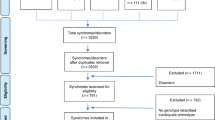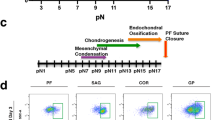Abstract
Apert syndrome is a genetic disorder characterised by craniosynostosis and structural discrepancy of the craniofacial region as well as the hands and feet. This condition is closely linked with fibroblast growth factor receptor-2 (FGFR2) gene mutations. Gene therapies are progressively being tested in advanced clinical trials, leading to a rise of its potential clinical indications. In recent years, research has made great progress in the gene therapy of craniosynostosis syndromes and several studies have investigated its influences in preventing/diminishing the complications of Apert syndrome. This article reviewed and exhibited different techniques of gene therapy and their influences in Apert syndrome progression. A systematic search was executed using electronic bibliographic databases including PubMed, EMBASE, ScienceDirect, SciFinder and Web of Science for all studies of gene therapy for Apert syndrome. The primary outcomes measurements vary from protein to gene expressions. According to the findings of included studies, we conclude that the gene therapy using FGF in Apert syndrome was critical in the regulation of suture fusion and patency, occurred via alterations in cellular proliferation. The superior outcome could be brought by biological therapies targeting the FGF/FGFR signalling. More studies in molecular genetics in Apert syndrome are recommended. This study reviews the current literature and provides insights to future possibilities of genetic therapy as intervention in Apert syndrome.
This is a preview of subscription content, access via your institution
Access options
Subscribe to this journal
Receive 12 print issues and online access
$259.00 per year
only $21.58 per issue
Buy this article
- Purchase on Springer Link
- Instant access to full article PDF
Prices may be subject to local taxes which are calculated during checkout




Similar content being viewed by others
References
Opperman LA, Chhabra A, Cho RW, Ogle RC. Cranial suture obliteration is induced by removal of transforming growth factor (TGF)-beta 3 activity and prevented by removal of TGF-beta 2 activity from fetal rat calvaria in vitro. J Craniofac Genet Dev Biol. 1999;19:164–73.
Panigrahi I. Craniosynostosis genetics: the mystery unfolds. Indian J Hum Genet. 2011;17:48.
Liu C, Cui Y, Luan J, Zhou X, Han J. The molecular and cellular basis of Apert syndrome. Intractable Rare Diseases Res. 2013;2:115.
Kreiborg S, Cohen M Jr. The oral manifestations of Apert syndrome. J Craniofacial Genet Dev Biol. 1991;12:41–8.
ŞOANCĂ A, Dudea D, Gocan H, Roman A, Culic B. Oral manifestations in Apert syndrome: case presentation and a brief review of the literature. Romanian J Morphol Embryol. 2010;51:581–4.
Tiwari A, Agrawal A, Pratap A, Lakshmi R, Narad R. Apert syndrome with septum pellucidum agenesis. Singapore Med J. 2007;48:e62–e5.
Kimonis V, Gold J-A, Hoffman TL, Panchal J, Boyadjiev SA, editors. Genetics of craniosynostosis. Seminars in pediatric neurology; 2007: Elsevier.
Wilkie AO. Craniosynostosis: genes and mechanisms. Hum Mol Genet. 1997;6:1647–56.
Teven CM, Farina EM, Rivas J, Reid RR. Fibroblast growth factor (FGF) signaling in development and skeletal diseases. Genes Diseases. 2014;1:199–213.
Anderson J, Burns HD, Enriquez-Harris P, Wilkie AO, Heath JK. Apert syndrome mutations in fibroblast growth factor receptor 2 exhibit increased affinity for FGF ligand. Hum Mol Genet. 1998;7:1475–83.
Moher D, Liberati A, Tetzlaff J, Altman DG. Preferred reporting items for systematic reviews and meta-analyses: the PRISMA statement. Ann Internal Med. 2009;151:264–9.
Hooijmans CR, Rovers MM, De Vries RB, Leenaars M, Ritskes-Hoitinga M, Langendam MW. SYRCLE’s risk of bias tool for animal studies. BMC Med Res Methodol. 2014;14:43.
OHAT/NTP. OHAT Risk of Bias Rating Tool for Human and Animal Studies. 2015.
Wheldon LM, Khodabukus N, Patey SJ, Smith TG, Heath JK, Hajihosseini MK. Identification and characterization of an inhibitory fibroblast growth factor receptor 2 (FGFR2) molecule, up-regulated in an Apert Syndrome mouse model. Biochem Journal. 2011;436:71–81.
Yin L, Du X, Li C, Xu X, Chen Z, Su N, et al. A Pro253Arg mutation in fibroblast growth factor receptor 2 (Fgfr2) causes skeleton malformation mimicking human Apert syndrome by affecting both chondrogenesis and osteogenesis. Bone. 2008;42:631–43.
Shukla V, Coumoul X, Wang R-H, Kim H-S, Deng C-X. RNA interference and inhibition of MEK-ERK signaling prevent abnormal skeletal phenotypes in a mouse model of craniosynostosis. Nat Genet. 2007;39:1145–50.
Pfaff MJ, Xue K, Li L, Horowitz MC, Steinbacher DM, Eswarakumar JVP. FGFR2c-mediated ERK–MAPK activity regulates coronal suture development. Dev Biol. 2016;415:242–50.
Greenwald JA, Mehrara BJ, Spector JA, Warren SM, Fagenholz PJ, Smith LP, et al. In vivo modulation of FGF biological activity alters cranial suture fate. Am J Pathol. 2001;158:441–52.
Warren SM, Brunet LJ, Harland RM, Economides AN, Longaker MT. The BMP antagonist noggin regulates cranial suture fusion. Nature. 2003;422:625.
Kim B, Shin H, Kim W, Kim H, Cho Y, Yoon H, et al. PIN1 attenuation improves midface hypoplasia in a mouse model of Apert syndrome. J Dental Res. 2020;99:223–32.
Xu W, Luo F, Wang Q, Tan Q, Huang J, Zhou S, et al. Inducible activation of FGFR2 in adult mice promotes bone formation after bone marrow ablation. J Bone Min Res. 2017;32:2194–206.
Mansukhani A, Bellosta P, Sahni M, Basilico C. Signaling by fibroblast growth factors (FGF) and fibroblast growth factor receptor 2 (FGFR2)-activating mutations blocks mineralization and induces apoptosis in osteoblasts. J Cell Biol. 2000;149:1297–308.
Shen K, Krakora SM, Cunningham M, Singh M, Wang X, Hu FZ, et al. Medical treatment of craniosynostosis: recombinant noggin inhibits coronal suture closure in the rat craniosynostosis model. Orthodontics Craniofacial Res. 2009;12:254–62.
Yeh E, Atique R, Ishiy FA, Fanganiello RD, Alonso N, Matushita H, et al. FGFR2 mutation confers a less drastic gain of function in mesenchymal stem cells than in fibroblasts. Stem Cell Rev. 2012;8:685–95.
Yokota M, Kobayashi Y, Morita J, Suzuki H, Hashimoto Y, Sasaki Y, et al. Therapeutic effect of nanogel-based delivery of soluble FGFR2 with S252W mutation on craniosynostosis. PLoS ONE. 2014;9:e101693.
Morita J, Nakamura M, Kobayashi Y, Deng CX, Funato N, Moriyama K. Soluble form of FGFR2 with S252W partially prevents craniosynostosis of the apert mouse model. Dev Dyn. 2014;243:560–7.
Zhang L, Chen P, Chen L, Weng T, Zhang S, Zhou X, et al. Inhibited Wnt signaling causes age-dependent abnormalities in the bone matrix mineralization in the apert syndrome FGFR2S252W/+ Mice. PLoS ONE. 2015;10:e112716.
Suzuki H, Suda N, Shiga M, Kobayashi Y, Nakamura M, Iseki S, et al. Apert syndrome mutant FGFR2 and its soluble form reciprocally alter osteogenesis of primary calvarial osteoblasts. J Cell Physiol. 2012;227:3267–77.
Tanimoto Y, Yokozeki M, Hiura K, Matsumoto K, Nakanishi H, Matsumoto T, et al. A soluble form of fibroblast growth factor receptor 2 (FGFR2) with S252W mutation acts as an efficient inhibitor for the enhanced osteoblastic differentiation caused by FGFR2 activation in Apert syndrome. J Biol Chem. 2004;279:45926–34.
Miraoui H, Ringe J, Häupl T, Marie PJ. Increased EFG-and PDGFα-receptor signaling by mutant FGF-receptor 2 contributes to osteoblast dysfunction in Apert craniosynostosis. Hum Mol Genet. 2010;19:1678–89.
Wilkie AO, Morriss-Kay GM. Genetics of craniofacial development and malformation. Nat Rev Genet. 2001;2:458.
Perlman RL. Mouse models of human disease: an evolutionary perspective. Evol Med Public Health. 2016;2016:170–6.
Schwerd T, Krause F, Twigg SRF, Aschenbrenner D, Chen Y-H, Borgmeyer U, et al. A variant in IL6ST with a selective IL-11 signaling defect in human and mouse. Bone Res. 2020;8:24.
McDowell LM, Frazier BA, Studelska DR, Giljum K, Chen J, Liu J, et al. Inhibition or activation of Apert syndrome FGFR2 (S252W) signaling by specific glycosaminoglycans. J Biol Chem. 2006;281:6924–30.
Von Gernet S, Golla A, Ehrenfels Y, Schuffenhauer S, Fairley J. Genotype–phenotype analysis in Apert syndrome suggests opposite effects of the two recurrent mutations on syndactyly and outcome of craniofacial surgery. Clin Genet. 2000;57:137–9.
Shin H-R, Bae H-S, Kim B-S, Yoon H, Cho Y-D, Kim W-J, et al. PIN1 is a new therapeutic target of craniosynostosis. Hum Mol Genet. 2018;27:3827–39.
Miraoui H, Ringe J, Haupl T, Marie PJ. Increased EFG- and PDGFalpha-receptor signaling by mutant FGF-receptor 2 contributes to osteoblast dysfunction in Apert craniosynostosis. Hum Mol Genet. 2010;19:1678–89.
Luo F, Xie Y, Wang Z, Huang J, Tan Q, Sun X, et al. Adeno-associated virus-mediated RNAi against mutant alleles attenuates abnormal calvarial phenotypes in an apert syndrome mouse model. Mol Therapy-Nucleic Acids. 2018;13:291–302.
Zhang L, Chen P, Chen L, Weng TJ, Zhang SC, Zhou X, et al. Inhibited Wnt signaling causes age-dependent abnormalities in the bone matrix mineralization in the apert syndrome FGFR2(S252W/+) Mice. PLoS ONE. 2015;10:e112716.
Nakamura T, Gulick J, Pratt R, Robbins J. Noonan syndrome is associated with enhanced pERK activity, the repression of which can prevent craniofacial malformations. Proc Natl Acad Sci USA. 2009;106:15436–41.
Collins M, Thrasher A. Gene therapy: progress and predictions. Proc R Soc B: Biol Sci. 2015;282:20143003.
Barik M, Bajpai M, Das RR, Panda SS. Study of environmental and genetic factors in children with craniosynostosis: a case-control study. J Pediatric Neurosci. 2013;8:89.
Mahale S, Dani N, Ansari SS, Kale T. Gene therapy and its implications in periodontics. J Indian Soc Periodontol. 2009;13:1.
Suwanmanee T, Ferris MT, Hu P, Gui T, Montgomery SA, Pardo-Manuel de Villena F, et al. Toward personalized gene therapy: characterizing the host genetic control of lentiviral-vector-mediated hepatic gene delivery. Mol Therapy Methods Clin Dev. 2017;5:83–92.
Nam HK, Vesela I, Schutte SD, Hatch NE. Viral delivery of tissue nonspecific alkaline phosphatase diminishes craniosynostosis in one of two FGFR2C342Y/+ mouse models of Crouzon syndrome. PLoS ONE. 2020;15:e0234073.
Mammen B, Ramakrishnan T, Sudhakar U. Principles of gene therapy. Indian J Den Res. 2007;18:196.
Maule G, Casini A, Montagna C, Ramalho AS, De Boeck K, Debyser Z, et al. Allele specific repair of splicing mutations in cystic fibrosis through AsCas12a genome editing. Nat Commun. 2019;10:3556.
Iriart JAB. Precision medicine/personalized medicine: a critical analysis of movements in the transformation of biomedicine in the early 21st century. Cadernos de saude publica. 2019;35:e00153118.
Acknowledgements
This work was supported by FRGS grant (FP103-2019A) from the Ministry of Higher Education, Malaysia (Ref: FRGS/1/2019/SKK10/UM/02/3).
Author information
Authors and Affiliations
Corresponding authors
Ethics declarations
Conflict of interest
The authors declare that they have no conflict of interest.
Additional information
Publisher’s note Springer Nature remains neutral with regard to jurisdictional claims in published maps and institutional affiliations.
Rights and permissions
About this article
Cite this article
Al-Namnam, N.M., Jayash, S.N., Hariri, F. et al. Insights and future directions of potential genetic therapy for Apert syndrome: A systematic review. Gene Ther 28, 620–633 (2021). https://doi.org/10.1038/s41434-021-00238-w
Received:
Revised:
Accepted:
Published:
Issue Date:
DOI: https://doi.org/10.1038/s41434-021-00238-w
This article is cited by
-
Bridging the gap between omics research and dental practice
BDJ Open (2024)



